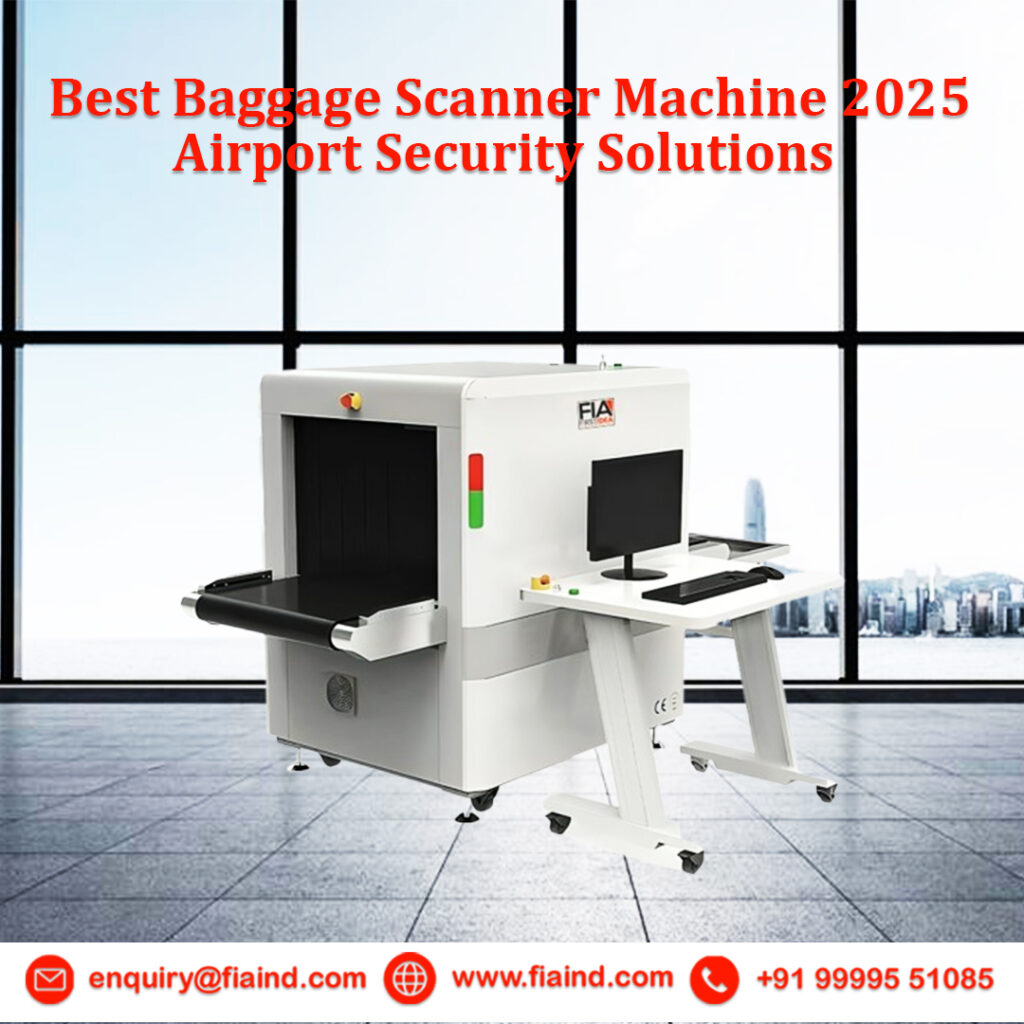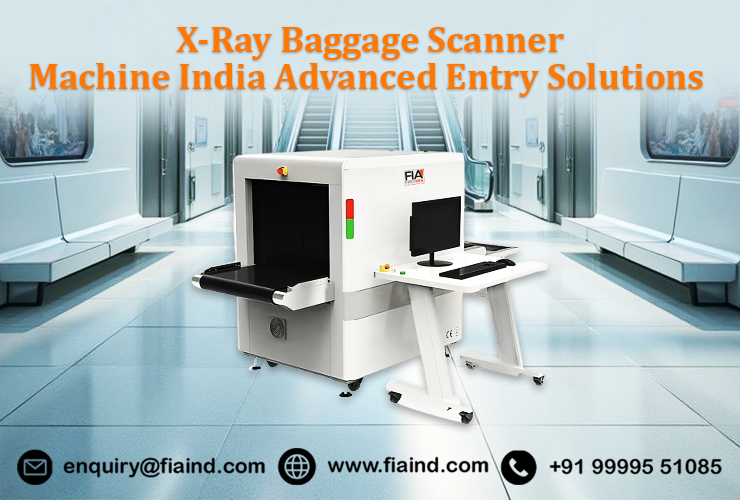In today’s aviation landscape, safety and speed are non-negotiable. With the exponential rise in air traffic across Indian airports, the need for efficient, intelligent, and reliable security screening systems has never been greater. Modern airports must balance operational efficiency with the highest security standards, ensuring smooth passenger experiences while preventing prohibited items from entering secure zones through Baggage Scanner Machine.
The x ray baggage scanner has emerged as a critical element of airport security infrastructure — detecting weapons, explosives, and contraband with precision and speed. As technology evolves, scanners are becoming smarter, faster, and more energy-efficient.
In this article, we’ll explore the best baggage scanner machines of 2025, highlighting the latest innovations, features, and solutions designed specifically for Indian airports. From AI-powered detection to 3D imaging, these systems are transforming how airports secure every journey.
Importance of Baggage Scanners in Modern Airport Security
Baggage scanners are the first line of defense in aviation security. They play an indispensable role in preventing threats and maintaining passenger trust. Without these systems, airports would struggle to detect dangerous items that could jeopardize public safety.
Key reasons baggage scanners are vital:
- Threat Detection: They identify concealed weapons, explosives, and narcotics that can bypass manual checks.
- Operational Efficiency: Automated systems reduce queue times, allowing airports to process higher passenger volumes efficiently.
- Safety Assurance: By screening every bag thoroughly, airports ensure a safe environment for travelers and staff.
- Regulatory Compliance: Indian airports must adhere to guidelines set by AERB and international standards like ECAC and TSA.
With India’s growing network of airports — from metro hubs like Delhi and Mumbai to regional expansions the demand for reliable baggage scanning technology continues to rise. Investing in the right equipment is not just a necessity; it’s a strategic advantage.
How Airport Baggage Scanning Technology Works
The science behind baggage scanners is both fascinating and essential. At the core, these machines use X-rays to inspect the contents of passenger baggage without opening them physically.
Here’s how it works step-by-step:
- Conveyor System: Luggage is placed on a moving belt that carries it through the scanner.
- X-ray Generation: The scanner emits controlled X-rays that penetrate the bag.
- Detection Sensors: Dual-energy detectors capture varying absorption levels of the X-rays.
- Image Formation: Software translates these signals into color-coded images on a display screen.
- Operator Analysis: Trained operators interpret the images to identify suspicious items.
Advanced baggage scanners now feature dual-view and 3D tomography imaging, allowing operators to view objects from multiple angles. This significantly improves detection accuracy and reduces false alarms.
Furthermore, modern systems use AI-based image recognition to automatically flag potential threats, enhancing both security and efficiency.
Key Features to Look for in the Best Baggage Scanner Machine 2025
Choosing a scanner involves more than just price — it’s about finding a balance between performance, safety, and compliance. In 2025, these are the must-have features every Indian airport should consider:
- High-Resolution Imaging: Allows precise differentiation between organic, inorganic, and metallic materials.
- Automatic Threat Detection (ATD): AI-powered software recognizes weapons, explosives, and other restricted items instantly.
- Compact, Modular Design: Suitable for airports with limited space or expansion constraints.
- Low Radiation Emission: Ensures operator safety and compliance with AERB standards.
- Energy Efficiency: Reduces power consumption and long-term operational costs.
- Network Connectivity: Enables centralized monitoring across multiple checkpoints.
- Compliance Certifications: Adherence to BIS, ECAC, and TSA standards for credibility and reliability.
Each of these features contributes to seamless operations, helping Indian airports manage security challenges efficiently while maintaining global aviation safety standards.
Top Baggage Scanner Machines in India (2025 Edition)
As of 2025, several global and Indian manufacturers have introduced advanced baggage scanning machines designed for Indian aviation needs. Below are some top models known for reliability and performance.
| Brand / Model | Key Features | Ideal For |
|---|---|---|
| EtradeFia HI-SCAN 6040 | Dual-view imaging, automatic detection, ECAC certified | Large international airports |
| Nuctech CX100100 | AI image analysis, remote diagnostics, compact footprint | Regional airports |
Indian airports are increasingly prioritizing “Make in India” compliant scanners, favoring local manufacturing with global-level technology integration. These machines are designed for high throughput, operational efficiency, and low maintenance — key factors for busy terminals.
Smart Innovations in 2025 Airport Security Scanning
The 2025 generation of baggage scanners integrates cutting-edge technologies that elevate security and efficiency. The convergence of AI, IoT, and cloud computing has ushered in a new era of intelligent screening.
Notable innovations include:
- Artificial Intelligence (AI): Automated threat detection reduces human error.
- Machine Learning (ML): Systems learn from previous scans to improve accuracy.
- Remote Diagnostics: Allows maintenance teams to monitor performance in real time.
- 3D Imaging: Offers more detailed object visualization, improving threat identification.
- Green Technology: Modern scanners use low-dose radiation and energy-saving systems.
These smart technologies minimize false alarms, optimize resource usage, and support predictive maintenance — ensuring uninterrupted operation even during peak hours.
Choosing the Right Baggage Scanner for Your Airport
Selecting the ideal scanner requires evaluating specific operational and regulatory factors. For Indian airports, the right choice balances cost, technology, and compliance.
Key considerations:
- Airport Size & Passenger Volume: Larger airports require high-throughput models.
- Space Availability: Compact designs suit smaller terminals.
- Detection Capability: Dual-energy and 3D scanners offer superior accuracy.
- Compliance: Always ensure the machine is AERB and BIS certified.
- After-Sales Support: Choose vendors with strong Indian service networks.
When making a purchase, look for total cost of ownership — not just upfront price. Reliable support and regular maintenance ensure long-term savings.
This section is also the ideal spot for internal linking to your reference page on baggage x ray machine, integrating the keyword naturally to guide readers deeper into related content.

Installation, Maintenance, and Operator Training
Proper installation and maintenance are critical for the scanner’s longevity and efficiency.
Here’s what airports should prioritize:
- Professional Installation: Certified technicians ensure the system is safely set up and calibrated.
- Routine Maintenance: Regular servicing minimizes downtime and ensures consistent performance.
- Software Updates: Keeps detection algorithms current with emerging threats.
- Operator Training: Well-trained personnel interpret images accurately and respond effectively.
- Compliance Checks: Regular audits ensure radiation levels meet AERB safety norms.
Investing in operator education enhances both safety and efficiency. Trained staff can identify suspicious patterns faster, reducing security risks and delays.
Case Study: Upgrading Airport Security Systems in India
Consider a mid-sized Indian airport that upgraded its baggage scanners in 2024. Before modernization, it faced long queues, frequent false alarms, and slow screening.
After deploying AI-powered dual-view scanners, results were remarkable:
- Processing speed increased by 40%.
- False positives dropped by 60%.
- Energy costs decreased by 15%.
- Passenger satisfaction scores improved significantly.
This case demonstrates how modern baggage scanners not only enhance safety but also improve operational metrics and passenger experience. Many airports are now partnering with certified Indian manufacturers to replicate these results nationwide.
Also Read:- X-Ray Baggage Scanner Machine India Advanced Entry Solutions
Future of Airport Security Scanners Beyond 2025
The next decade promises even more transformative changes in baggage scanning technology. As airports evolve into smart hubs, scanners will integrate with broader digital ecosystems.
Upcoming trends:
- 3D Computed Tomography (CT): Offers detailed visualization for automatic detection.
- AI-driven Pattern Recognition: Identifies unknown threats based on behavioral data.
- Cloud-based Monitoring: Centralized system management across airports.
- Integration with Biometric Systems: Syncs scanning data with passenger identification.
- Non-X-ray Technologies: Millimeter-wave and terahertz imaging for non-invasive inspection.
These advancements will redefine the balance between speed, accuracy, and passenger comfort. Indian airports are well-positioned to lead this shift, with growing investments in AI and digital transformation.
Compliance, Certification, and Safety Standards in India
Every baggage scanner used in India must comply with national and international safety regulations. Compliance ensures safety for both passengers and operators while maintaining credibility during audits.
Essential Certifications:
- AERB (Atomic Energy Regulatory Board): Mandatory for all X-ray emitting devices.
- BIS Certification: Confirms adherence to Indian quality standards.
- ECAC & TSA Approvals: Required for international airports and global operations.
- ISO 9001 & ISO 14001: Indicate consistent manufacturing and environmental management.
Procurement officers should always verify documentation before installation. Non-compliance can lead to penalties, safety risks, and invalid insurance coverage.
Elevating Airport Security with the Best Baggage Scanner Machine in 2025
India’s aviation sector is undergoing a powerful transformation — with record-breaking passenger growth and increasing security demands. The best baggage scanner machine of 2025 is no longer just a detection device; it’s a smart, AI-driven command center for secure and efficient airport management.
Modern scanners combine AI analytics, dual-energy imaging, and eco-friendly technology to provide rapid, accurate detection without slowing down operations. These systems are designed for high-throughput terminals, helping airports handle thousands of bags per hour while maintaining strict compliance with AERB and international aviation safety standards.
Moreover, these scanners are not limited to airports alone. Many are now being deployed across government buildings, metro systems, embassies, and logistic facilities across India — ensuring layered protection in public infrastructure.
By adopting such technology, Indian airports not only strengthen national security but also elevate the passenger experience — creating a seamless, trustworthy travel environment for millions of flyers every year.
Final Thought
As we look ahead to 2025 and beyond, one thing is clear: airport security is evolving at a rapid pace. The investment in next-generation baggage scanners is not just about compliance — it’s about ensuring safety, efficiency, and readiness for tomorrow’s challenges.
The right baggage scanner integrates intelligence, automation, and durability. It empowers airports to detect faster, process smarter, and operate safer — reducing risks while enhancing public confidence.
For airport authorities and institutional buyers, the future lies in choosing solutions that align with India’s aviation modernization vision — solutions that combine cutting-edge technology, local manufacturing strength, and long-term reliability.
To explore the latest scanning technologies shaping the next decade of secure travel, check our detailed technical guide on x ray scanners, which highlights future innovations driving airport safety worldwide.

















